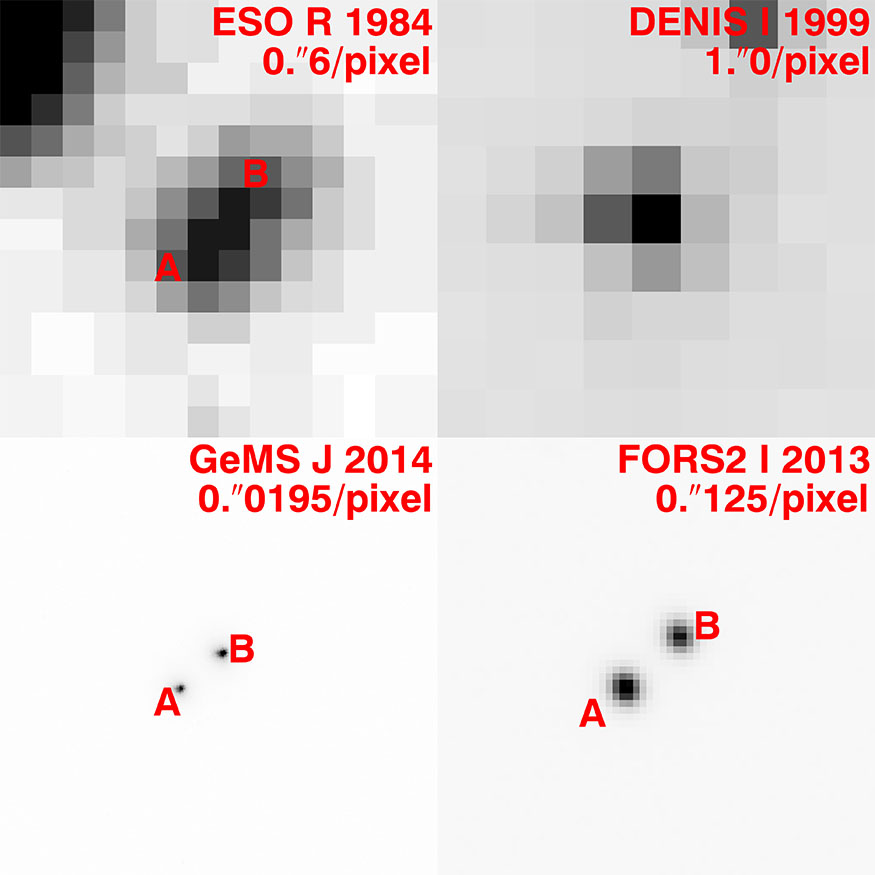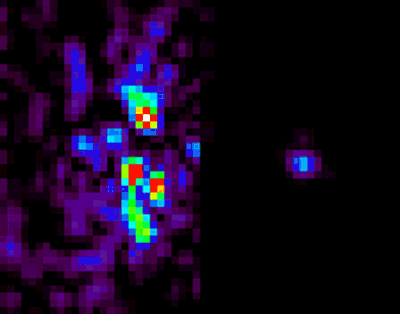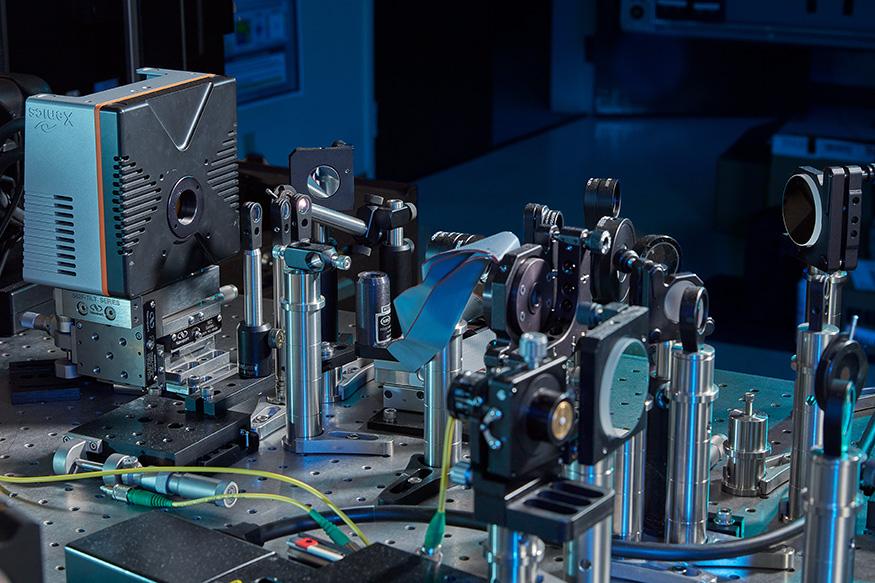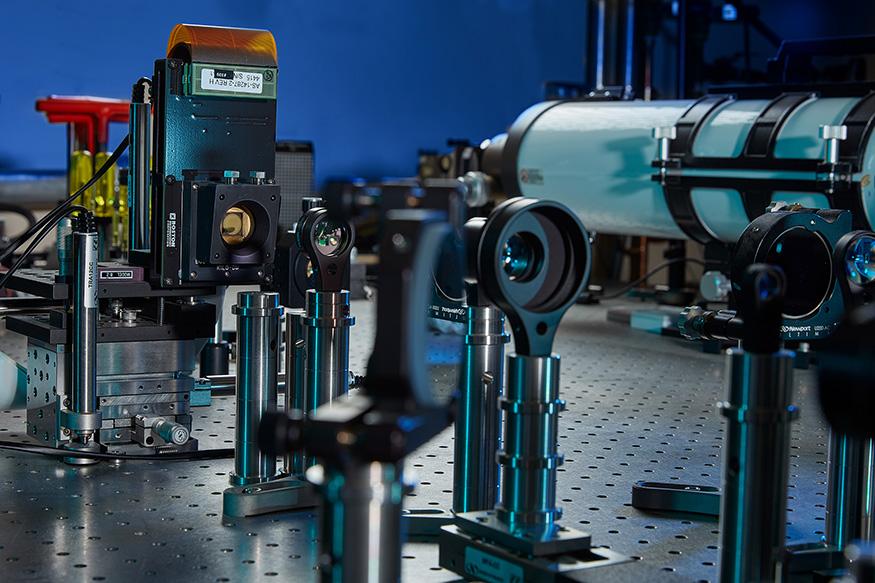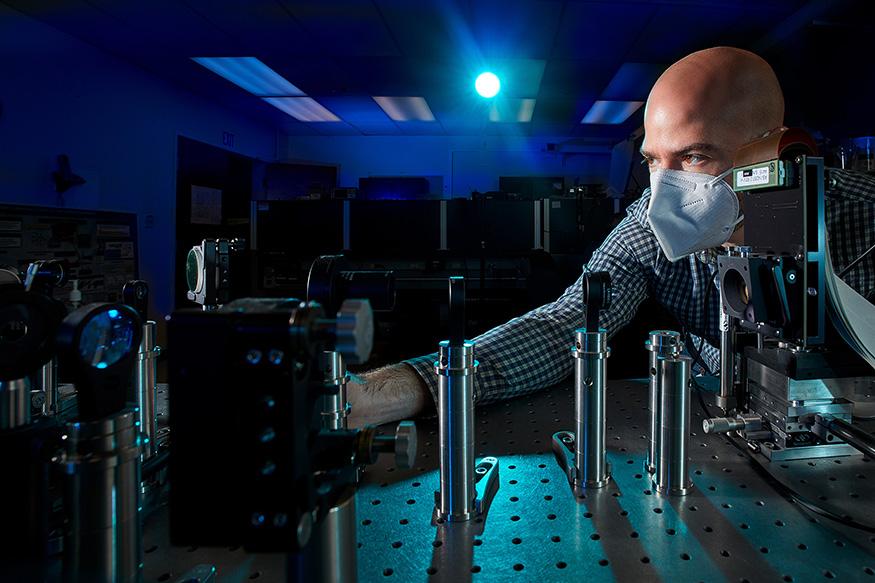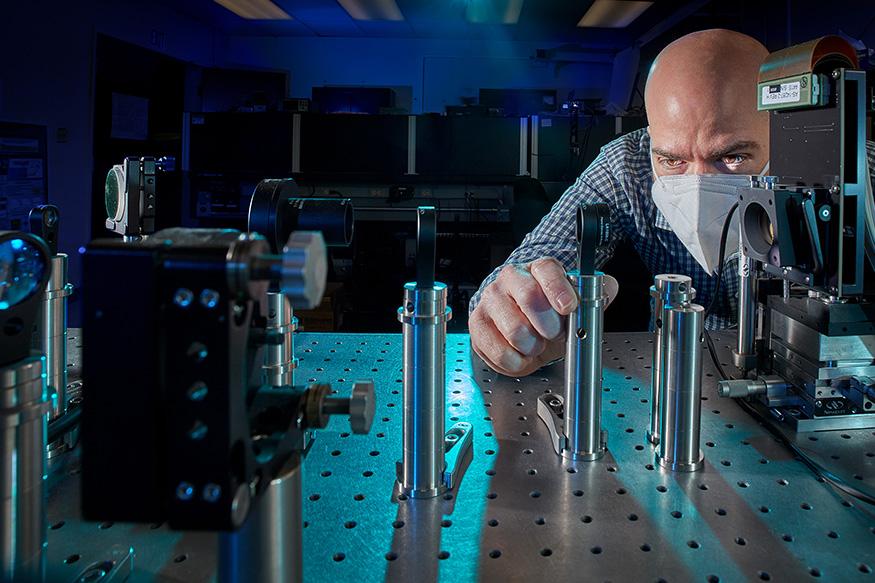Adaptive optics
Lawrence Livermore researchers are developing and applying advanced adaptive optics technologies to observe extrasolar planets and brown dwarfs.
Observing objects beyond our solar system
Astronomers use observations of extrasolar planets (“exoplanets”) to help determine the answer to a key puzzle: What are exoplanets composed of and how do planetary systems form? High-resolution, high-contrast observations are important for gleaning relevant information about planets and debris disks, but they are exceedingly difficult because Earth’s turbulent atmosphere typically blurs the images.
One way to improve image quality is to send telescopes into orbit, such as the Hubble Space Telescope or Roman Space Telescope. Another approach is to equip large telescopes on the ground—larger than space telescopes and up to 42 meters with the next generation of Extremely Large Telescopes (ELTs)—with adaptive optics (commonly known as “AO”). AO compensates in real time for the distortions of light caused by Earth’s atmosphere so that faint objects can be seen with exquisite resolution.
LLNL has been at the cutting edge of AO development for several decades. This experience, plus the intersection of physics, optical engineering, and control systems expertise at LLNL make it an ideal place to apply and continue developing novel AO technologies for astronomical science.
Through our research, we seek to:
Further our understanding of extrasolar planets and brown dwarfs using AO systems on ground-based telescopes
Develop advanced AO and laser guide star technology for large astronomical telescopes
Push AO correction to visible wavelengths for astronomy and other applications
Revolutionary exoplanet and brown dwarf science
Key parameters in the study of both planets and low-mass brown dwarfs are their mass and distance, which advanced astronomical AO systems such as the Gemini Planet Imager (GPI) do not measure directly. Rather, we indirectly measure parameters such as temperature or luminosity that can be combined with evolutionary tracks to produce mass estimates. A direct, independent measurement of mass allows us to estimate the specific entropy of the object separately from evolutionary tracks, constrain its equation of state, and distinguish between different formation models. The best way to do this is to measure the reflex motion of the parent star in the plane of the sky by comparison to reference stars.
As an exemplar of this technique, using novel multi-laser guide star technology installed on the Gemini telescopes, we made the first precise measurements of the closest known binary brown dwarf system, Luhman 16 AB. The observations yielded an estimate of its relative orbital parameters and thus a constraint of the brown dwarf masses. We also used the Keck laser guide star and the Shane adaptive optics system at Lick Observatory to obtain distance measurements for two extremely faint T-type brown dwarfs, WISE2154 and WISE1901.
Advancing technology
Through an analysis with Stanford University, we found that important performance limiters for high-contrast AO instruments, such as the GPI, are control system latencies and temporal wavefront errors. These issues affect the system’s ability to keep up with ever-evolving atmospheric turbulence. Addressing these issues is necessary for the success of future large telescopes, updating the performance of existing systems, and pushing adaptive optics to visible wavelengths.
Motivated by this finding, our team developed the Low-Latency Adaptive Mirror System (LLAMAS) testbed to advance the state of the art in adaptive optics latencies. LLAMAS is an onsite system that will test techniques and solutions in an integrated, real-time, closed-loop AO system. LLAMAS has demonstrated an order of magnitude improvement in closed-loop bandwidth (740 Hz), improved from about 30 Hz for the GPI.
The next generation of Extremely Large Telescopes (ELTs) require AO systems that challenge the current state of the art. These larger apertures of up to 42 meters require deformable mirrors with higher actuator counts, better performance at visible wavelengths, and faster computers to command deformable mirrors. LLNL’s AO research program is focused on developing prototypes that will advance the technology in preparation for ELTs.
Applications beyond astronomy
Our adaptive optics technologies and expertise are applicable to other fields, including biological imaging and medicine. We have carried out pioneering work in retinal vision, producing extremely high-resolution images of the retina. Our AO team has joined with colleagues in x-ray optics to develop x-ray deformable mirrors aimed at enhancing the capabilities of synchrotron facilities.
People
| Name | Title | Discipline |
|---|---|---|
| Team | ||
Collaborators
| Name | Department | Institution |
|---|---|---|
| Pierre Baudoz | Paris Observatory | |
| Jeff Chilcote | Department of Physics | Notre Dame |
| Raphaël Galicher | Paris Observatory | |
| Phil Hinz | Laboratory for Adaptive Optics | University of California Observatories |
| Rebecca Jensen-Clem | Laboratory for Adaptive Optics | University of California, Santa Cruz |
| Quinn Konopacky | Center for Astrophysics and Space Sciences | University of California, San Diego |
| Jessica Lu | Adaptive Optics and Astrometry Group | University of California, Berkeley |
| Bruce Macintosh | Director’s Office | University of California Observatories |
| Claire Max | Laboratory for Adaptive Optics | University of California Observatories |
| Julia Scharwaechter | Gemini North Adaptive Optics Team | Gemini Observatory |
| Garima Singh | Gemini Observatory | |
| Gaetano Sivo | Gemini North Adaptive Optics Team | Gemini Observatory |
| Maaike van Kooten | National Research Council of Canada | |
| Jean-Pierre Véran | National Research Council of Canada |
Select publications
High-speed Focal Plane Wave Front Sensing with an Optical Chopper | Publications of the Astronomical Society of the Pacific, 2023
B.L. Gerard, D. Dillon, S. Cetre, R. Jensen-Clem
Trigonometric Parallaxes of Two T Dwarfs With Keck and Shane AO Astrometry | Publications of the Astronomical Society of the Pacific, 2021
J. Nguyen, S.M. Ammons, K. Dennison, E.V. Garcia, J.R. Lu, S. McMillan, M. Salama
Debris Disk Results from the Gemini Planet Imager Exoplanet Survey’s Polarmetric Imaging Campaign | The Astronomical Journal, 2020
T.M. Esposito et al
The Gemini Planet Imager Exoplanet Survey: Giant Planet and Brown Dwarf Demographics from 10 to 100 AU | The Astronomical Journal, 2019
E. Nielsen et al
LLAMAS: Low Latency Adaptive Optics at LLNL | Proceedings of the SPIE, 2018
S.M. Ammons, B. Bauman, G. Burton, C. Gates, J. Dawson, B. Hackel, D. Homoelle, M. Kim, G. Larkin, D.W. Palmer, R. Panas, P. Pax, L.A. Poyneer
Individual, Model-Independent Masses of the Closest Known Binary Brown Dwarf Binary to the Sun | Astrophysical Journal, 2017
E.V. Garcia, S.M. Ammons, M. Salama, I. Crossfield, E. Bendek, J. Chilcote, V. Garrel, J.R. Graham, P. Kalas, Q. Konopacky, J.R. Lu, B. Macintosh, E. Marin, C. Marois, E. Nielsen, B. Neichel, D. Pham, R.J. De Rosa, D.M. Ryan, M. Service, and G. Sivo
Discovery of a Substellar Companion to the Nearby Debris Disk Host HR 2562 | The Astrophysical Journal Letters, 2016
Q. Konopacky et al
Direct Imaging of an Asymmetric Debris Disk in the HD 106906 Planetary System | The Astrophysical Journal, 2015
P. Kalas et al
Integrated Laboratory Demonstrations of Multi-Object Adaptive Optics on a Simulated 10 Meter Telescope at Visible Wavelengths | Publications of the Astronomical Society of the Pacific, 2010
S.M. Ammons, L. Johnson, E.A. Laag, R. Kupke, B.J. Bauman, D.T. Gavel, C.E. Max

